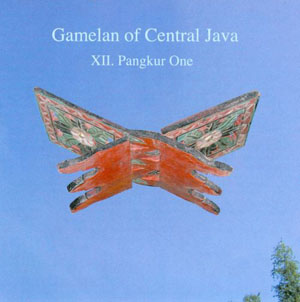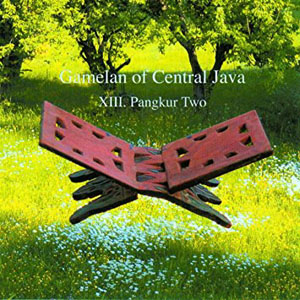“Pangkur” denotes a kind of music in the Javanese classical canon that can take many forms — sung poetry, court dances, and many other idioms — and can be performed in either slendro or pelog scales. It is perhaps the most versatile and unpredictable form to come out of the Javanese classical tradition.
 Pangkur One presents what is referred to as the “larger” form, with full gamelan orchestra and soloists. Reading the notes to these selections by noted Indonesian musicologist Bapak Sumarsam, one realizes that one of the key components of Javanese music is density. This becomes apparent in the first Ladrang Pangkur (all four pieces on this disc are titled Ladrang Pangkur, in which “ladrang denotes the specific structure of the composition), as the music moves from dense orchestral textures to very lean solo passages, accented again by the changes in tempo. The text, called rujak-rujakan, is noted as “playful,” which my still fairly unschooled ear has to take on faith — if I had to describe the mood here, I think I’d go for “pastoral.”
Pangkur One presents what is referred to as the “larger” form, with full gamelan orchestra and soloists. Reading the notes to these selections by noted Indonesian musicologist Bapak Sumarsam, one realizes that one of the key components of Javanese music is density. This becomes apparent in the first Ladrang Pangkur (all four pieces on this disc are titled Ladrang Pangkur, in which “ladrang denotes the specific structure of the composition), as the music moves from dense orchestral textures to very lean solo passages, accented again by the changes in tempo. The text, called rujak-rujakan, is noted as “playful,” which my still fairly unschooled ear has to take on faith — if I had to describe the mood here, I think I’d go for “pastoral.”
The second Pangkur embraces a very different mood, almost festive at the beginning, although much more spare than the opening measures of the first offering. There is an amazing complexity to the music that maintains a rich underlying texture in the instrumentals as the piece progresses. The interchanges between the soloist and chorus are engaging, the long vocal lines adding an overarching coherence to the piece.
And yet another shift in mood introduces the third version, slow, almost pensive at first, but rapidly moving into a livelier, more percussive section. Changes in rhythm mark this song, although they are apparent throughout the collection, but here they seem to be more prevalent and more obvious.
The last selection features a new vocal part, not making use of the rujak-rujakan, sung by a mixed chorus, which adds yet another variation to the basic Pangkur. This one is strongly reminiscent of other gendhing I’ve heard, with the same combination of liveliness and stateliness that marks so much of the Javanese music in my experience. Once again, the variations in density and tempo prove very engaging, often throwing the contrasts between soloist and chorus into high relief.
The commentary accompanying this disc is of limited use to those not familiar with Javanese musical terminology — the notes are, in fact, fairly hard going, at least until you can keep a few basic definitions in your head.
 Pangkur Two features what the back text calls “side dishes” — shorter pieces played by a reduced ensemble. Call it “chamber music.” The feeling is the same throughout the disc — intimate, with greater transparency in the textures and more prominence given to the singing. Indeed, the first selection, Macapat Pangkur Paripurna, is purely vocal. I have to say, I’m very glad that my ear has finally tuned itself to the singing styles of Asia. I found these works, out of all the gamelan I’ve listened to in recent years, the most enchanting. Mind you, this is coming someone who’s always had a special love for sonatas, string quartets, and the like, and the selections on this disc fit right into that mold.
Pangkur Two features what the back text calls “side dishes” — shorter pieces played by a reduced ensemble. Call it “chamber music.” The feeling is the same throughout the disc — intimate, with greater transparency in the textures and more prominence given to the singing. Indeed, the first selection, Macapat Pangkur Paripurna, is purely vocal. I have to say, I’m very glad that my ear has finally tuned itself to the singing styles of Asia. I found these works, out of all the gamelan I’ve listened to in recent years, the most enchanting. Mind you, this is coming someone who’s always had a special love for sonatas, string quartets, and the like, and the selections on this disc fit right into that mold.
Among my favorites here are the opening track; track 3, Ladrang Pangkur (with an unknown soloist who does a bang-up job); track 7, Macapat Pangkur Dhudha Kasmaran, again with a stellar vocal; and track 10, the final selection, that has a magical quality to it that I can’t quite pin down, but it’s very special.
To go back to my opening remarks, Pangkur Two, even more than Pangkur One, displays the malleability of this type, all in a series of smaller scale pieces that make the music immediate and engaging in a way that I don’t think larger ensembles can. It really is the difference between a full orchestra and a string quartet, in many ways, and it’s quite refreshing.
.
Go here for Volume XIV.
(Both Felmay, 2010)
